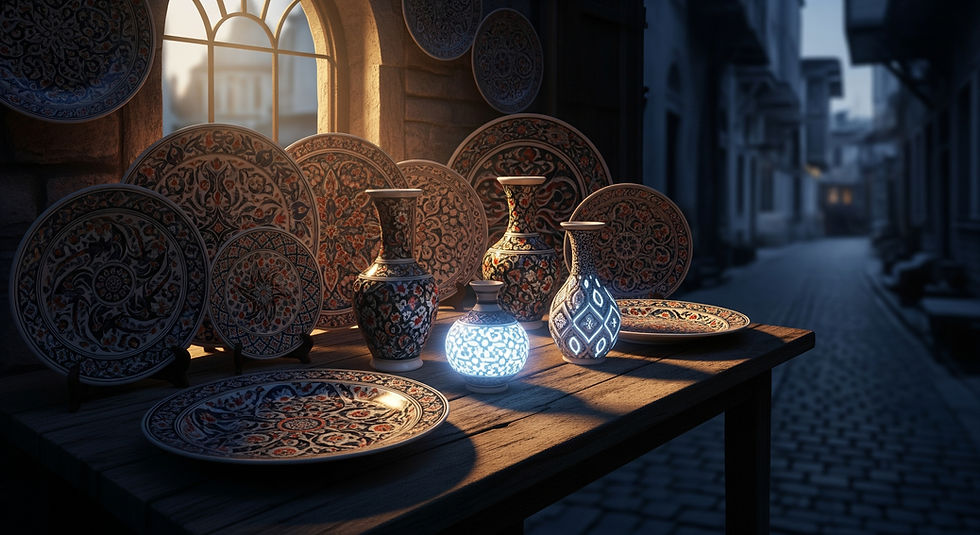A Short History of Glow-in-the-Dark Ceramics
- suleymanokan
- Jun 27
- 3 min read
Updated: Jul 11
Nestled in the winding streets of Istanbul's historic Sultanahmet district, Q-arts is proud to celebrate the rich heritage of Turkish ceramics. While visitors are often enchanted by bold patterns and brilliant blues, there is a quieter magic in some pieces that shimmer subtly in dim light. Although glowing ceramics are not an established historical category, a few modern artists, inspired by Ottoman elegance and scientific curiosity, have created pieces with soft luminescent effects. Here, we separate legend from legacy, sharing the true story of Turkish ceramic brilliance and where today's innovations are taking us.
The Brilliance of Ottoman Ceramics
Turkey's celebrated ceramic traditions date back centuries, with major centers of production including Iznik, Kütahya, and Çanakkale. Iznik tiles, flourishing in the 16th and 17th centuries, are famed for their vibrant underglaze colors and intricate floral motifs. Kütahya later emerged as a center of domestic ceramics, producing richly colored household items and religious wares, especially in the 18th century. Çanakkale, by contrast, is known for its more rustic, folk-art aesthetic with animal figurines and bright colors. Each region developed distinct forms and styles, though none are historically known for glow-in-the-dark techniques.
What links these ceramics is their sophisticated use of color and glaze. Artists experimented with various mineral-rich pigments to achieve vivid cobalt blues, manganese purples, and emerald greens. These colors were not luminescent but rather prized for their brilliance under natural and candlelight. While the surfaces could gleam under soft lighting, there is no historical documentation of self-luminescing glazes.
Lighting Up Today: Modern Experiments in Ceramic Glow
The idea of ceramics that glow in the dark has captivated modern ceramicists worldwide. In contemporary pottery, luminescent effects are achieved using phosphorescent compounds—often strontium aluminate doped with rare earth elements—that absorb light and slowly re-emit it. These are modern innovations, introduced long after the classical periods of Turkish pottery.
In Turkey today, a handful of ceramicists are experimenting with such materials, often combining traditional forms with new technology. These pieces, sometimes marketed as "moonstone ceramics" or "luminous pottery," are inspired by historical aesthetics but rely on scientific understanding not available in earlier centuries. Some use natural minerals blended with non-toxic phosphors to create subtle glowing effects, a fascinating intersection of ancient craft and modern chemistry.
Tradition Meets Innovation
At Q-arts, we embrace this bridge between the old and new. While our traditional tiles and vessels pay homage to Iznik and Kütahya styles, we also feature a small selection of contemporary ceramics that use safe, modern luminescent glazes. These pieces are not recreations of historical items but rather interpretations—artworks that honor the elegance of Ottoman design while embracing 21st-century materials.
These glowing ceramics are particularly popular with visitors looking for one-of-a-kind decor that adds a gentle light to nighttime spaces. Whether placed in an entryway, meditation nook, or beside a candlelit bath, these pieces evoke a calm, poetic atmosphere.
What to Look For
If you're intrigued by glowing pottery, here are a few tips for spotting genuine pieces:
Material: True luminescent ceramics use phosphorescent glaze, not painted-on glow effects.
Glaze Quality: Look for a smooth, even glaze without thick ridges or bubbling—a sign of quality firing.
Design: Many contemporary Turkish artists echo traditional motifs like tulips, saz leaves, or architectural silhouettes in their glow ceramics.
While the notion of glowing Ottoman ceramics is more myth than documented history, the allure of light in Turkish design is very real. From the shimmering domes of Sultanahmet to the gleam of tilework in candlelight, light has always played a role in Turkish artistry. Today, modern ceramicists continue that tradition by exploring new ways to bring brightness into our homes.
We invite you to visit Q-arts in Sultanahmet and see this blend of heritage and innovation for yourself. Whether you're drawn to timeless Iznik patterns or intrigued by luminous glazes, there is a piece here that glows with the spirit of Turkey.
